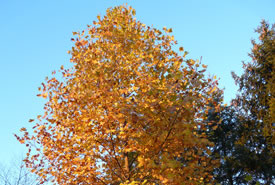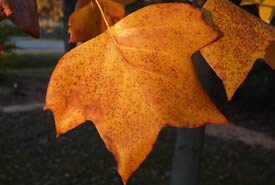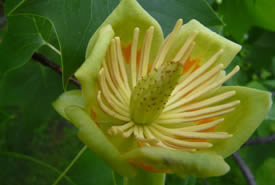My southern beauty

A tuliptree in fall (Photo by Bernt Solymar)
As I sat on the hillside staring out at hundreds of lilacs, I couldn’t help but notice the giant trees shading out large patches of land. I’d never seen such a large tree in southern Ontario before, and I was fascinated. I had to know what I was staring at. I grabbed my Trees of Ontario identification book and took off to find a leaf from this gentle giant.
Its leaves were large, lobed and bright green. At first glance, it resembled a maple leaf, but the longer I studied it the more it became clear to me that this was a unique species. Then I spotted flowers on the tree, made up of large, thick, green-and-orange petals. They were arranged in a cup shape and sat on the branches like waterlilies. Identifying this tree was now a breeze — it was none other than the tuliptree!

Tuliptree leaf in fall (Photo by Bernt Solymar)
This was the day I fell in love with the tuliptree. This species is unique, with its crown-shaped leaves and flowers with thick, waxy petals. How had I lived for 20 years, frolicking in these forests, and never seen a tree like this before? Where did it come from? Was it native to the area or simply planted in a botanical garden as part of its living collection?

Tuliptree flower (Photo by Bernt Solymar)
With a little research, I learned that the tuliptree grows in a very specific forest range called the Carolinian life zone, which spans from the Carolinas in the United States, up into Ontario, ending in Grand Bend on the shores of Lake Huron. It is a fast-growing species that needs full sunlight to flourish. It blooms in early spring, around the same time that lilacs start to fill gardens with their easily recognizable scent.
This giant can grow to up to 35 metres high and live for more than 150 years. Its bright green leaves change to a bright yellow in the fall, providing vibrant colours throughout the seasons. The tuliptree is becoming increasingly rare, as it grows in a very particular habitat and competes for space with human development.
In an effort to protect this tree, and other unique species like it that are found only in the Carolinian life zone, the Nature Conservancy of Canada has protected land in order to secure this ecosystem. To see one of these beauties for yourself, visit NCC’s Backus Woods property, and make sure you go back in May to see the incredible flowers.
And on that note, I wish you a Happy National Forest Week! Now, go hug a tree.


